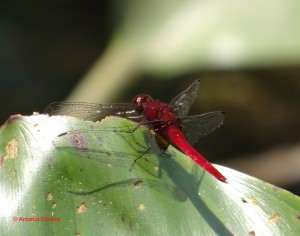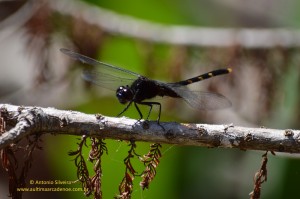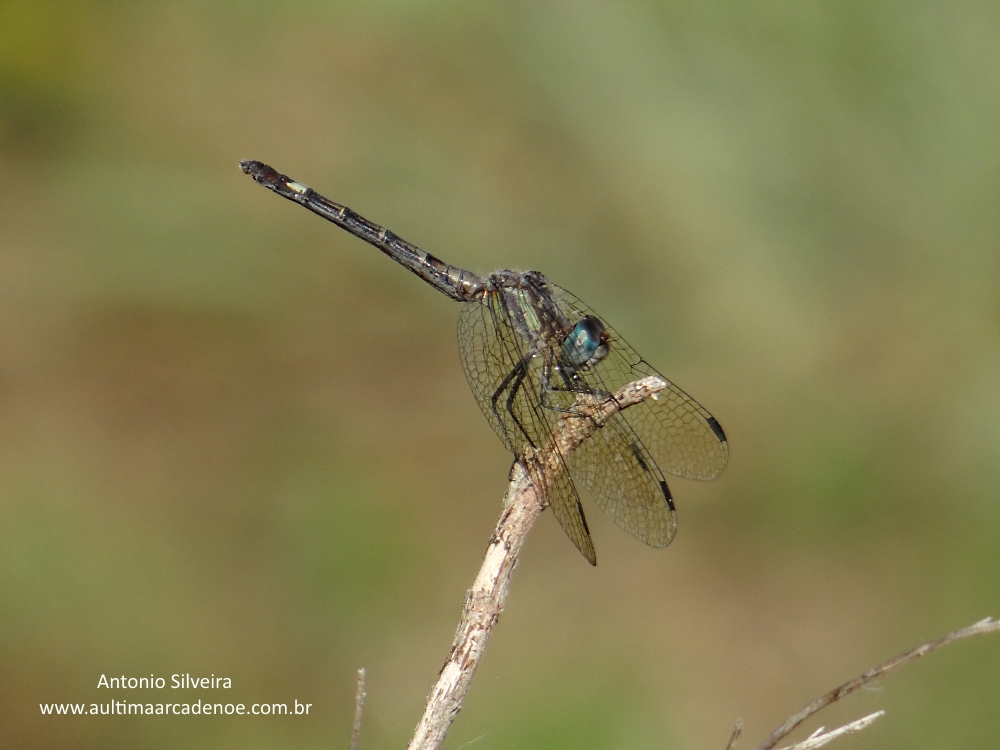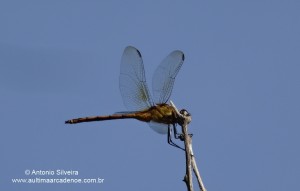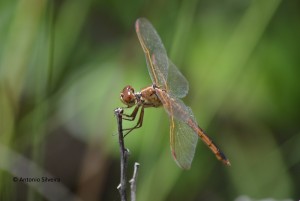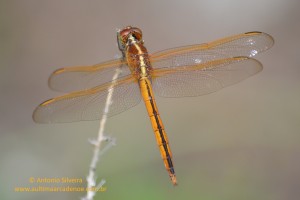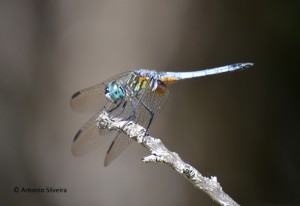Libélulas (dragonflies)
Portuguese and English —-
As Libélulas ou Dragonflies como são conhecidas mundialmente, são insetos do pertencentes a ordem Odonata, com grande poder de voo. Alimentam-se de mosquitos principalmente, que pegam no ar mostrando grande capacidade de voo e velocidade.
A Ordem Odonata dividem-se nas seguinte subordem:
1-Anisozygoptera (não ocorre no Brasil)
2-Zygoptera (donzelinhas ou damselflies). Possui 18 famílias, das quais 10 ocorrem no Brasil: Amphipterygidae, Calopterygidae, Coenagrionidae, Dicteriadidae, Lestidae, Megapodagrionidae, Perilestidae, Polythoridae, Protoneuridae e Pseudostigmatidae.
3- Anisoptera (as libélulas ou dragonflies). Possue oito famílias, no Brasil ocorrem só três: Aeshnidae, Gomphidae e Libellulidae.
As donzelinhas (zygoptera) tem o corpo mais fino, é mais delicada do que as libélulas, e suas asas são do mesmo tamanho e quando pousadas as asas ficam paralelas ao corpo. Nas Libélulas (Anisoptera) o corpo é mais robusto e as asas posteriores são mais curtas que as anteriores e quando pousam as asas ficam perpendiculares ao corpo.
Existem cerca de 5.600 espécies de odonatas no mundo, ocorrendo cerca de 800 espécies no Brasil, podendo aumentar em mais 300 pelos últimos estudos (Souza,LOI;Costa,JM;Oldrini,BO.Ordem Odonata,PDF on line)
São insetos que vivem próximo a poças de água, riachos e lagos. Suas larvas são aquáticas e se chamam naiades e são carnívoras vorazes como os adultos.
A cópula é singular onde o macho “agarra” a fêmea pela nuca com sua extremidade do corpo. A fêmea curva o corpo e facilita
o contato dos órgãos reprodutores, o que fazem inclusive voando.
Depois deposita os ovos na superfície da água em movimentos repetidos e rápidos, como tivemos a oportunidade de ver e registrar muitas vezes (foto abaixo).
Os adultos tem vida efêmera pois vivem de uma a duas semanas, normalmente.
Pelo seu modo de vida as odonatas são animais bioindicadores de qualidade ambiental, em especial da água.
As libélulas estão entre os animais que chamam muito a atenção das pessoas e são muito apreciadas como objeto de fotografia.
Inclusive há muito muitos locais especiais para a sua observação, as chamadas Dragonflies trails, principlamente em parques nos EUA,como no Wetlands Park, em Las Vegas.
Mas o país onde há mais interesse sobre o tema é a Inglaterra onde existem muito estudos e publicações
como o famoso Journal of the British Dragonfly Society , talvez a mais importante publicação sobre o assunto.
O continente africano é muito rico em Odonatas e também há muitos estudos sobre estes insetos (Africa Dragonfly).
E um dos websites mais completos do mundo é: Odonata Central
O turismo de observação de libélulas é uma atividade recente mas de grande potencial e que deve ser incentivado pelos gestores de áreas verdes das cidades e mesmo em áreas rurais. por Antonio Silveira.
——————————-
——-ENGLISH
The Dragonflies as they are known worldwide, are insects belonging to the order Odonata, with great flight power. They feed on mosquitoes mainly to take in the air showing great flight capacity and speed.
The Order Odonata are divided into the following suborder:
1-anisozygoptera (does not occur in Brazil)
2- Zygoptera (donzelinhas ou damselflies). Possui 18 famílias, das quais 10 ocorrem no Brasil: Amphipterygidae, Calopterygidae, Coenagrionidae, Dicteriadidae, Lestidae, Megapodagrionidae, Perilestidae, Polythoridae, Protoneuridae e Pseudostigmatidae.
3- Anisoptera (as libélulas ou dragonflies). with eigth families, in Brazil only three: Aeshnidae, Gomphidae e Libellulidae.
(conf.Souza, Bridget dragonflies diversity (Insecta:. odonata) in areas of natural vegetation in the municipality Barroso, MG.2012).
The donzelinhas (zygoptera) has the thinnest body, is more delicate than dragonflies, and their wings are the same size . when perched the wings are parallel to the body. In Dragonfly (Anisoptera) the body is more robust and subsequent wings are shorter than the previous land and when the wings are perpendicular to the body.
There are about 5,600 species of odonatas in the world, about 800 species in Brazil. With the possibility of moremore 300, by new works ((Souza,LOI;Costa,JM;Oldrini,BO.Ordem Odonata,PDF on line)
Are insects that live near puddles, streams and lakes. Their larvae are aquatic and call “naiades” are carnivorous and voracious as the adults.
Copulation is unique where the male “holds by the neck” the female by the neck with his end of the body. The female body curves and facilitates the contact of the reproductive organs, which are even flying.
After lays eggs on the surface of water in repeated and rapid movements, as we had the opportunity to see and record many times (photo below).
Adults have short life because they live in one to two weeks, usually.
By their way of life the animals odonatas are bioindicators of environmental quality in particular water.
Dragonflies are among the animals most call people’s attention and are much appreciated as photos object.
Including very many special places for your observation, Dragonflies trails calls, maily in parks in the US, as in the Wetlands Park in Las Vegas.
But the country where there is more interest in the subject is England where there are a lot of studies and publications
as the famous Journal of the British Dragonfly Society, perhaps the most important publication on the subject.
The African continent is very rich in Odonatas and there are also many studies about these insects (Africa Dragonfly).
And one of the most complete websites in the world is: Odonata Central
The dragonfly watching tourism is a recent activity but of great potential and should be encouraged by managers
green areas of cities and even in rural areas. by Antonio Silveira.
———————————-
Veja abaixo fotos de odonatas de Antonio Silveira e colaboradores/ see below photos of odonatas by Antonio Silveira and contributors
———————————-
Fotos de algumas espécies de Odonatas no Brasil (Photos of some Odonata species in Brazil)
Erythrodiplax sp; Jardim Botânico SP.BR. (below)
Ischnura-ramburii (a couple) Aruba, (below)
Orthemis discolor ; Carmine Skimmer (probably) (below)
outras espécies não identificadas (other unidentified species)
 Jardim Botânico São Paulo (São Paulo Botanical Garden)
Jardim Botânico São Paulo (São Paulo Botanical Garden)
 Pirassunuga-SP,Brasil (biol.Antonio Bordignon em contribuição)
Pirassunuga-SP,Brasil (biol.Antonio Bordignon em contribuição)
———————————————
Fotos de algumas espécies de Odonatas do Uruguay: Laguna del Diario, Maldonado. (photos of some Odonata species in Uruguay)
Probably Ischnura fluviatilis (below)
outras espécies não identificadas (other unidentified species)

——————————————–
Algumas Odonatas de Aruba (Caribe): Bubali Bird Sanctuary. (some odonatas in Aruba, Caribbean)
Probably Brachymesia furcata (Red-tailed Pennant) (below)
Ischnura ramburii (Rambur´s Forktail) (below)
——————————————–
Algumas odonatas da America do Norte (some dragonflies of North America)
Anax junius (Drury, 1773) ; Green darner . Sunset Pk -Las Vegas,NV (below)
Argia immunda (Hagen), 1861; Kiowa Dancer . Wet Land Pk Las Vegas, NV (below)
Celithemis eponina (Drury, 1773); Halloween Pennant.- Oleta River St.Park,Miami-FL (below)
Enallagma boreale – Sunset Pk- Las Vegas-NV (below)
Erythemis simplicicollis (Say, 1839); Eastern Pondhawk – Everglades N.P. FL (below)
Erythemis versiculosa (Fabricius, 1775) ; Great Pondhawk. OletaRiverStPk-Miami (below)
Erythrodiplax umbrata, Oleta River St Park, Miami, Florida (below)
Libellula auripennis – Everglades NP-FL (below)
Libellula incesta – Big Cipress N.R. FL (below)
Libellula needhami – Oleta River St Park-Miami – FL (below)
Libellula saturata – Sunset Pk-Las Vegas-NV (below)
Pachydiplax longipennis -Wet Land Pk-Las Vegas-NV (below)
Pantala hymenaea – Wet Land Pk-Las Vegas-NV (below)
Tramea lacerata (Black Saddlebags) -Oleta River StPk-Miami- FL (below)
And others below recordeds in Miami, Florida
————————————–
SOME VIDEOS: LIBÉLULAS / DRAGONFLIES (recorded by Antonio Silveira)
Libelula, Laguna del Diario UY 15 4 2015 Antonio Silveira
Libelula negra, Laguna del Diario UY 15 4 2015 Antonio Silveira
Libelulas, copulando, JdBotânico-SP-Br 4 4 2015 Antonio Silveira
Libelula, Oleta River StPk, Miami 31 3 2015 Antonio Silveira
Orthemis sp, Miami,BotGarden 29 3 2015 Antonio Silveira
Orthemis ferruginea, StKitts,Caribe 25 3 2015 Antonio Silveira
Libelula fêmea colocando ovos- JdBotanicoSP BR 14 2 2015 Antonio Silveira
Libelula negra (Black Dragonfly) Laguna del DiarioUY 29 1 2015 Antonio Silveira
Red Dragonfly, Laguna del DiarioUY 27 2 2015 Antonio Silveira
Black Dragonfly, Laguna del DiarioUY 27 2 2015 Antonio Silveira
Libelula cruzando JDBotSP BR 11 12 14 ASilveira
Libelula, Picinguaba-Ubatuba-SP-Brasil-10-1991-Antonio Silveira
————————————-




